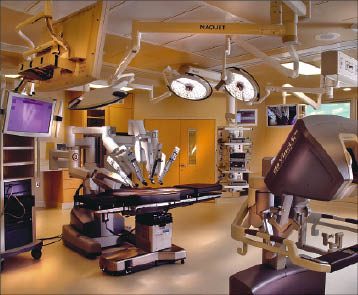
Home » Head and neck surgeons turn to robotics
Head and neck surgeons turn to robotics
Spokane ENT doctors team with Sacred Heart to offer new procedures

December 2, 2010
Spokane Ear, Nose & Throat Clinic PS has formed a new division in partnership with Providence Sacred Heart Medical Center & Children's Hospital that will offer advanced robotic surgery procedures for treating throat cancers, sleep apnea, and thyroid disease.
The procedures, which involve the use of recently developed tools and techniques created for the da Vinci Robotic Surgical System, allow surgeons to remove hard-to-reach malignant and benign tumors and tissues while preserving patients' abilities to speak and swallow, says Dr. Brian Mitchell, of Spokane ENT.
Mitchell and Dr. Jeffrey Bunn, also of Spokane ENT, are microvascular surgeons who specialize in major surgeries of the head and neck. They recently trained in transoral robotic surgeries, also called TORS, and are heading up Spokane ENT's new division, Northwest Head & Neck Center, Mitchell says.
TORS procedures usually are performed from the inside out, with tiny, remotely controlled instruments, as opposed to conventional open surgery, Mitchell says. Open surgeries of the mouth and neck often involve large throat incisions to gain access to tumors and defects, he says.
"In the old days, if the patient had tumors that we couldn't get to easily, it required more extensive surgery where we had to move neck tissues and jawbones out of the way," Mitchell says.
Those surgeries require longer hospitalizations, and can take months to recover the abilities to speak and swallow, he says.
Sacred Heart has formed a head and neck tumor board that will recommend appropriate treatments, including TORS, conventional surgery, radiation, and chemotherapy, on a case-by-case basis, Mitchell says. The board includes specialists in oncology, radiology, surgery, and other specialties.
"It's like getting multiple opinions in a one-stop shop," he says.
Candidates for TORS include throat and mouth cancer patients who have small tumors that haven't spread to the lymph nodes or beyond the head and neck area, Mitchell says.
The procedure also can be used to treat some cases of thyroid disease. In such cases, the surgeon can use robotic techniques to access the thyroid gland, which is located in the lower part of the neck below the Adam's apple, via an incision under the arm. The procedure is especially useful for removing small nodules or a portion of the thyroid gland, and leaves a small hidden scar rather than the highly visible scar following open thyroid surgery, Mitchell says.
TORS also can be used to treat some cases of obstructive sleep apnea, a condition characterized by interruptions of breathing during sleep when enlarged or excess throat tissues collapse and obstruct the airway, Mitchell says. Such tissues are difficult to access using conventional surgery, he says.
"Within our specialty, we expect advances so the scope will be expanded," Mitchell says.
The Northwest Head & Neck Center is Spokane ENT's first partnership with Sacred Heart, which owns the da Vinci equipment, he says.
"We needed a capital partner," Mitchell says. "In a private-practice group, it's difficult to buy that equipment yourself."
The da Vinci robot alone costs more than $1 million. Sacred Heart has three of them. Special equipment for TORS procedures costs another $200,000, the hospital says.
The partnership will enable patients to stay in Spokane rather than have to travel to Seattle or Portland for such surgical treatments, Mitchell says.
The robots also are used by other surgeons here for certain cardiac, gynecological, and prostate procedures.
In robotic surgical procedures, a surgeon sits at a console in the operating room and uses hand-operated controllers to guide movement of the robot's arms remotely. The arms have wrist-like-joints and "hands" that can be configured to hold custom devices such as blades, retractors, and cauterizing equipment.
The surgeon controls the robot's movements while monitoring 3-D images provided through a tiny binocular camera.
Depending on the TORS procedure, the robot will be fitted with one camera arm and two or three instrument arms, Mitchell says.
A surgeon who pioneered TORS recently trained Mitchell and Bunn in robotic procedures at the University of Texas MD Anderson Cancer Center, in Houston, he says.
Mitchell and Bunn will use a team approach in which both surgeons will participate in TORS procedures to minimize the amount of time patients will be in the operating room and under anesthesia.
"One of us will be at the console to control the arms of the robot," he says. "One of us will be bedside, also actively participating in the procedure."
Mitchell says the cost of the robotic surgical procedure might be more expensive than conventional surgery, but when one factors in a quicker recovery time for speaking and swallowing and a shorter hospital stay, "the total package can be quite a bit less than the traditional, open procedure."
He says he and Bunn anticipate performing robotic surgeries on two to three patients every two weeks.
Bunn has been with Spokane ENT for eight years, and Mitchell joined the practice two years ago. Both were hired straight out of fellowship programs in Indiana, he says.
Spokane ENT is a 12-physician practice based at a 33,000-square-foot main clinic at 217 W. Cataldo. It also operates two 7,000-square-foot, one-story clinics—one on the North Side, at 9922 N. Nevada, and the other in Spokane Valley, at 13414 E. Mission.
Latest News
Related Articles




